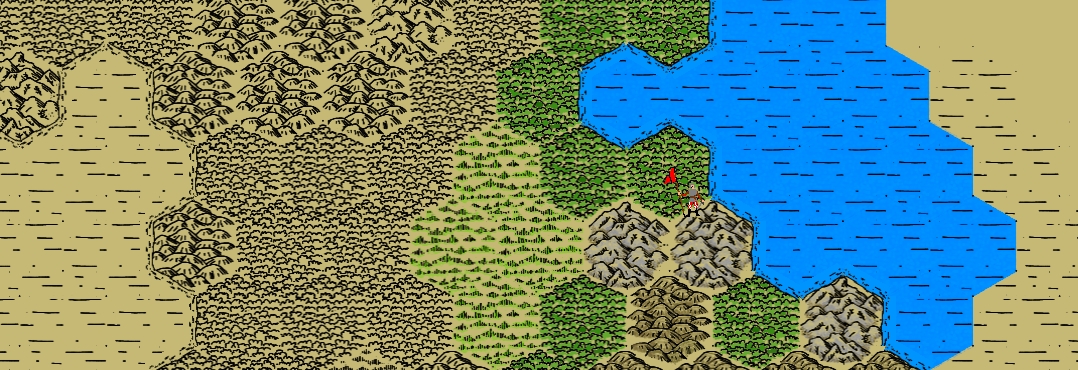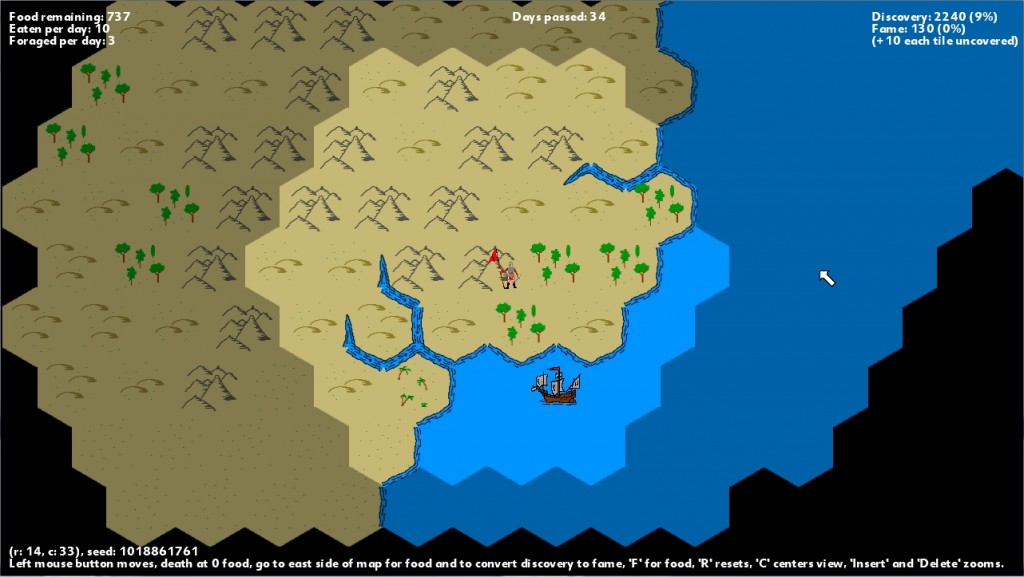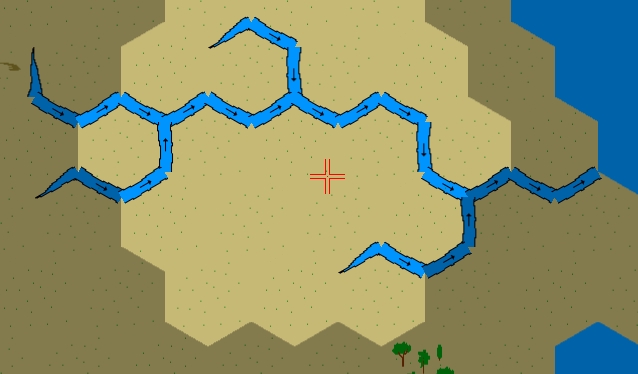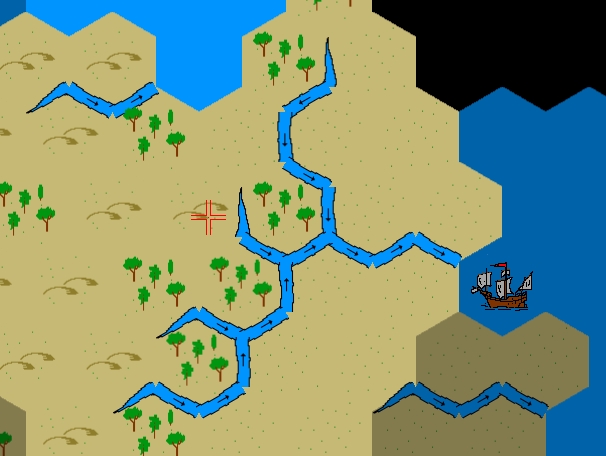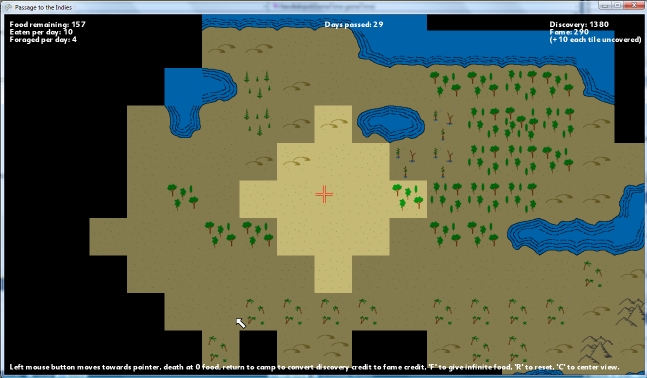Just a quick post showing off the new artwork for my game, Into the New World (formerly known as Passage to the Indies and, before that, something else that I can’t remember). The style is based off of the work of the brilliant cartographer, Erwin Raisz. Ignore the silly looking explorer graphic, I’ll be changing it to something a bit more appropriate to the new style. Now that I’m back from vacation, over my illness, and the kids are settling into school I’m hoping to put some serious time into the game and knock it out in the next few months.
August 26, 2011
June 17, 2011
Passage to the Indies second drop available
The second drop for Passage to the Indies is ready. Simply click on the link below to download the .zip file. Then run the setup.exe within to install Passage to the Indies. You’ll need to use the Control Panel to remove it, however.
Passage to the Indies download
From the previous drop’s note, my intention for this drop was “…adding rivers, sailing to and from Europe (the right side of the map), and some (at least rudimentary) random land form generation.” I accomplished all of that and more.
- Randomly generated land forms including rivers
- Sailing (including to and from Europe represented by the right edge of the map)
- Zooming in and out of the map to get a wider view
- Rivers block passage (except for the river’s source, which can be walked around)
- New hex-based presentation
- New icon for the player on foot and at sea
- Percentage display for discovery and fame credit
There is an issue in that the icon for the player at sea (a boat) always faces left. I’ll fix that soon enough, just wasn’t that important.
For the next drop I’d like to accomplish the following:
- Terrain assigned according to biome rules
- Creation of “points of interest” (river sources, vast forests, etc.) for additional fame gain
- Introduction of men, goods, and gold (at least) to the player state
- Natives, perhaps
I look forward to your feedback in the Quarter to Three thread! And if you see something wrong with a map note the row, column, and seed (all displayed in the lower left of the screen) so I can reproduce it. Thanks!
June 16, 2011
River code finally done!
Well, it turned out to be a lot harder than expected but I’ve finished the river code for Into the New World (the likely new name for the exploration game). I really like the river below — not only is it fairly long but it branches in interesting ways. I know the graphics aren’t great, but you can see the river source and regular river graphics (with black arrow indicating flow on the regular river graphic). More to come soon!
Oh, another river I just ran into is below!
May 31, 2011
Passage to the Indies first drop available
The first drop for Passage to the Indies is ready. Simply click on the link below to download the .zip file. Then run the setup.exe within to install Passage to the Indies. You’ll need to use the Control Panel to remove it, however.
Passage to the Indies download
This first drop represents a very primitive, but playable, version of the game. The explorer (represented by a red crosshair for now), having landed in the New World while searching for a passage to the Indies, is in camp. He has already gained some fame as a result of the landing. The explorer can be moved about the new land, uncovering terrain for discovery credit. Once the explorer returns to camp discovery credit is “cashed in” for fame credit. In the final game this will be analogous to returning to Europe and making known the discoveries. Basically, discovery credit is only good if the explorer returns alive. This will hopefully be an interesting gameplay dynamic between cashing in versus pushing it to the limit to make more discoveries before returning to camp (Europe, eventually).
Time only passes while the explorer is moving. Though this will have to be changed should multiplayer ever be added, I’m happy with it for now. Eventually there will need to be a “wait for X time period” capability so that the explorer can hunker down in the event of bad weather and the like but for now that is not needed. Time is constant (at about a day per second of movement) but the rate at which the explorer moves varies by terrain. Mountains are the slowest and plains the fastest, with the other terrain types falling in between.
The terrain type the explorer is traversing also determines the explorer’s maximum sight range. Forests offer the least range while mountains offer the most. Also higher terrain than the explorer is standing on can limit his sight range. For example, if the explorer is traversing plains they will not be able to see hills beyond a mountain nearer to him. However, he can see a mountain beyond a hill nearer to him (but not a forest beyond that hill). It is hoped that offering greater sight range (and the resulting increase in discovery credit from uncovered terrain) will make mountains and other difficult terrain appealing, despite their impact on movement. Terrain that is currently visible is lighter than discovered but not currently visible terrain. Black areas are as yet undiscovered.
Finally, the explorer starts with only 300 food. Once the food is gone the explorer dies. Food is currently eaten at a rate of ten per day. Various terrain types, however, allow for that rate to be lessened by allowing for foraging. Foraging is currently automatic but won’t remain that way in the future (interesting gameplay could arise from assigning crew to foraging, or having a native guide along that knows the land and offers a better foraging modifier). Deserts currently offer the least in the way of foraging while forests (jungle, evergreen, or deciduous) offer the most. Eventually weather, season, etc. will play into this (as well as into sight range, above).
There are a couple of issues with this drop. First, the coastal tiles don’t allow any walking on them even when the shoreline looks walkable. I’ll fix this soon, but the coast just looked way too cool to not put in. Second, there is an occasional frame stutter when scrolling / moving — I’ll try and knock that out soon too. Finally, winning is a bit open to interpretation. Since the explorer can’t get any more than 300 food and can’t retire winning is accomplished by having the greatest amount of fame (not discovery!) credit at time of death. Morbid, I know!
For the next drop I’ll be looking at adding rivers, sailing to and from Europe (the right side of the map), and some (at least rudimentary) random land form generation.
October 12, 2010
Introducing Passage to the Indies
Today being Columbus Day I figured it’d be as good a time as any to introduce the game I’m working on, Passage to the Indies (name likely to change at some point, but it is good enough for now).
Passage to the Indies is a game of exploration, both of the historical New World as well as random maps. I’m very aware of prior art in this genre (what little of it there is, sadly, as it is a very underrepresented genre in gaming) and seek to draw on their strengths as well as bring a few new elements to the mix.
First it is helpful to define Passage to the Indies in terms of what it is not:
- It is not a military-oriented game. There won’t be tactical battle screens or managing soldiers of different types.
- It is not a city builder. While the player will be able to found settlements, forts, missions, and trading posts they will not actively manage them thereafter.
- It is not an economic strategy game. No trading beaver furs for buffalo hide or setting up trade routes.
- It is not a total representation of history. No smallpox wiping out whole populations nor slavery. Yes, it happened. Doesn’t mean it would enhance a game that is based on exploration at a fairly abstract level.
What, then, is Passage to the Indies?
Passage to the Indies is a game that places the player in the role of an explorer during the late fifteenth to early seventeenth centuries. In addition to the historically accurate New World the player will be able to explore randomly generated hemispheres with realistic topography, biomes, climates, and native populations. Native populations will vary in strength, organization, technological advancement, and wealth. The disposition of the native populations can be affected positively or negatively through the direct and indirect actions of the player.
The player can sail for Spain, England, the Netherlands, or France. Exploration goals that all four powers share in common include uncovering new territory, discovering natural wonders, and documenting the flora and fauna of the New World. Other goals are conquest, religious crusade, settlement, and trading in nature with the four powers favoring a subset of these. The player’s renown and fortune will be heavily influenced by the goals he or she completes, how competently they were achieved, and how they aligned with the sponsoring power. Forts, missions, settlements, and trading posts help achieve these goals and provide passive bonuses as well as a renown boost or hit for the player depending on their long-term success.
The player will be managing a number of men and ensuring that they are fed. In addition to food these men can carry Old World goods (for trade with the natives), gold and other precious resources, and New World flora and fauna (accompanying the player on the voyage back home). Players can secure gold and other precious resources through trade or conquest. While conquest may be faster it is not always the most prudent route. Food is not only brought over from the Old World but can also be plundered, traded for, or foraged. In addition to the common man the player also has two “slots” open for specialists. Specialists include academics (documenting flora and fauna and providing a greater renown boost on return to the Old World), cartographers (more accurate maps, reduced chance of getting lost), officers (increased fighting capability), native guides (increased travel speed, better foraging), and more.
Combat will not be a very complex affair. It will factor relative strengths, account for the explorer’s often overwhelming technological edge, terrain, morale, and the like and inform the player of likely success or failure (accuracy of which is helped by having an officer specialist). The engagement will be resolved automatically (no tactical battle maps).
The player’s success is measured by an overall metric of their renown, wealth, and longevity. The game begins with the player in their youth and continues until their death or retirement due to age. Some reflection of the player’s success should be available while in the Old World, perhaps their home or their trophy-laden study.
In addition to the player there will also be computer-controlled explorers (representing both the player’s power and the other powers) exploring the New World. Their actions can affect the world as well and could serve to help or hinder the player. The powers will go to war from time to time changing relationships between the computer-controlled explorers and the player. There is the potential for other human-controlled explorers but that may be a bit too ambitious initially.
I believe the key to representing the Age of Exploration is to focus on the experience of being a member of a very small band in an unknown and (sometimes) hostile land. The desire to see what lies beyond the ridge on the horizon tempered by the knowledge that returning home is not a given. There is an inherent risk / reward that is very appealing. Discovering the Grand Canyon doesn’t mean much if the player doesn’t make it back to the Old World to spread the word. It is also important to represent the odd things that happened as well — explorers deciding to live with the natives, explorers of one expedition caught by natives only to be freed by another expedition years later (see Juan Ortiz), returning to find ones ships have decided to, or been forced to, move on. These would likely be handled through random events that occur infrequently. I’d also like to see an option to populate the New World with some of the fantastic places sought by those early explorers — El Dorado, the Fountain of Youth, etc.
The presentation will be a 2D top-down view of the New World at a large scale with line-of-sight and fog of war limiting player vision. I’m not a huge fan of tons of dialogs so as much of the game play will be kept in the main window as possible. While I expect to hire an artist late in development initially it’ll be programmer (i.e., me)-generated assets. I’ll probably go the route of licensing some period appropriate tunes and some sound effects rather than contracting out the sound design (and as I have almost zero capability in this area the early phases of this project will be sound-free, unfortunately).
I must be realistic, however. While I have outlined what I believe is a fairly reasonable design this is a hobbyist effort on my part. Though I am often working on the game (which is implemented in XNA and will be available on the PC and XBL Indie Games) and will update this blog regularly I can’t commit to a firm release date at this point. More details (and hopefully some pictures at some point!) as they become available…
